Ian Simon
Live Music Models
Aug 06, 2025Abstract:We introduce a new class of generative models for music called live music models that produce a continuous stream of music in real-time with synchronized user control. We release Magenta RealTime, an open-weights live music model that can be steered using text or audio prompts to control acoustic style. On automatic metrics of music quality, Magenta RealTime outperforms other open-weights music generation models, despite using fewer parameters and offering first-of-its-kind live generation capabilities. We also release Lyria RealTime, an API-based model with extended controls, offering access to our most powerful model with wide prompt coverage. These models demonstrate a new paradigm for AI-assisted music creation that emphasizes human-in-the-loop interaction for live music performance.
Adaptive Accompaniment with ReaLchords
Jun 17, 2025Abstract:Jamming requires coordination, anticipation, and collaborative creativity between musicians. Current generative models of music produce expressive output but are not able to generate in an \emph{online} manner, meaning simultaneously with other musicians (human or otherwise). We propose ReaLchords, an online generative model for improvising chord accompaniment to user melody. We start with an online model pretrained by maximum likelihood, and use reinforcement learning to finetune the model for online use. The finetuning objective leverages both a novel reward model that provides feedback on both harmonic and temporal coherency between melody and chord, and a divergence term that implements a novel type of distillation from a teacher model that can see the future melody. Through quantitative experiments and listening tests, we demonstrate that the resulting model adapts well to unfamiliar input and produce fitting accompaniment. ReaLchords opens the door to live jamming, as well as simultaneous co-creation in other modalities.
ReaLJam: Real-Time Human-AI Music Jamming with Reinforcement Learning-Tuned Transformers
Feb 28, 2025Abstract:Recent advances in generative artificial intelligence (AI) have created models capable of high-quality musical content generation. However, little consideration is given to how to use these models for real-time or cooperative jamming musical applications because of crucial required features: low latency, the ability to communicate planned actions, and the ability to adapt to user input in real-time. To support these needs, we introduce ReaLJam, an interface and protocol for live musical jamming sessions between a human and a Transformer-based AI agent trained with reinforcement learning. We enable real-time interactions using the concept of anticipation, where the agent continually predicts how the performance will unfold and visually conveys its plan to the user. We conduct a user study where experienced musicians jam in real-time with the agent through ReaLJam. Our results demonstrate that ReaLJam enables enjoyable and musically interesting sessions, and we uncover important takeaways for future work.
SingSong: Generating musical accompaniments from singing
Jan 30, 2023
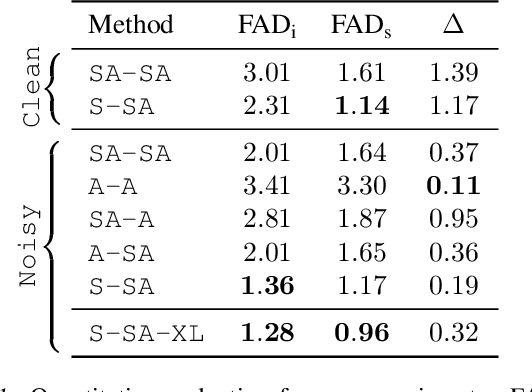

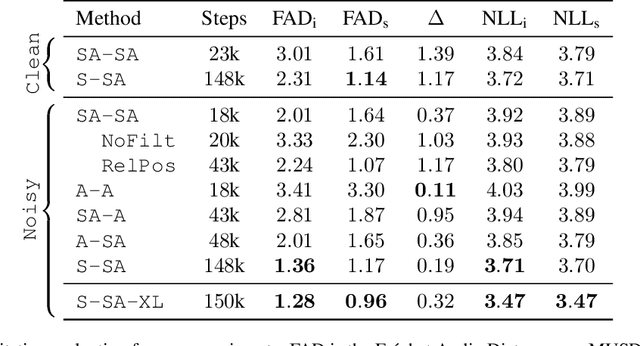
Abstract:We present SingSong, a system that generates instrumental music to accompany input vocals, potentially offering musicians and non-musicians alike an intuitive new way to create music featuring their own voice. To accomplish this, we build on recent developments in musical source separation and audio generation. Specifically, we apply a state-of-the-art source separation algorithm to a large corpus of music audio to produce aligned pairs of vocals and instrumental sources. Then, we adapt AudioLM (Borsos et al., 2022) -- a state-of-the-art approach for unconditional audio generation -- to be suitable for conditional "audio-to-audio" generation tasks, and train it on the source-separated (vocal, instrumental) pairs. In a pairwise comparison with the same vocal inputs, listeners expressed a significant preference for instrumentals generated by SingSong compared to those from a strong retrieval baseline. Sound examples at https://g.co/magenta/singsong
The Chamber Ensemble Generator: Limitless High-Quality MIR Data via Generative Modeling
Sep 28, 2022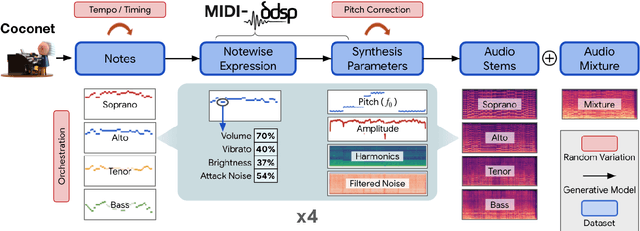
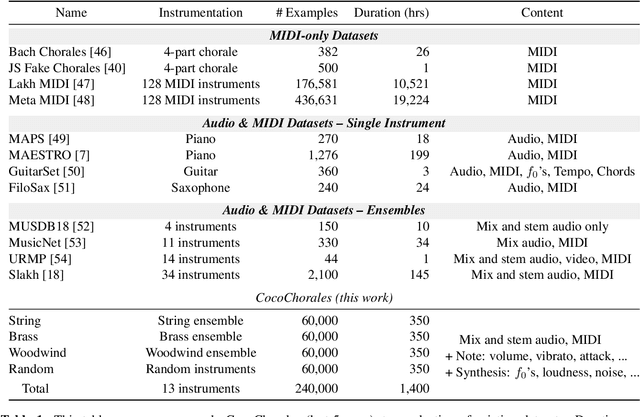
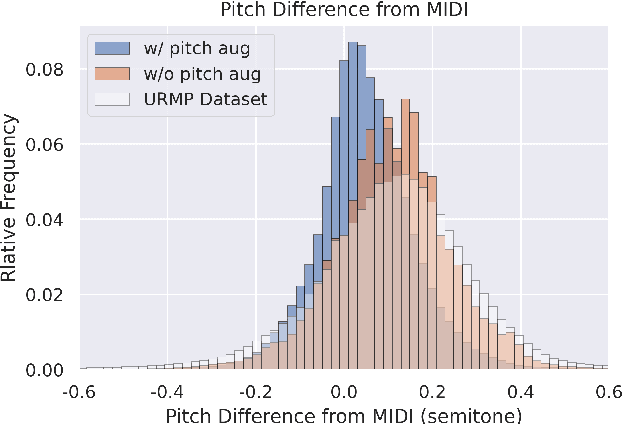

Abstract:Data is the lifeblood of modern machine learning systems, including for those in Music Information Retrieval (MIR). However, MIR has long been mired by small datasets and unreliable labels. In this work, we propose to break this bottleneck using generative modeling. By pipelining a generative model of notes (Coconet trained on Bach Chorales) with a structured synthesis model of chamber ensembles (MIDI-DDSP trained on URMP), we demonstrate a system capable of producing unlimited amounts of realistic chorale music with rich annotations including mixes, stems, MIDI, note-level performance attributes (staccato, vibrato, etc.), and even fine-grained synthesis parameters (pitch, amplitude, etc.). We call this system the Chamber Ensemble Generator (CEG), and use it to generate a large dataset of chorales from four different chamber ensembles (CocoChorales). We demonstrate that data generated using our approach improves state-of-the-art models for music transcription and source separation, and we release both the system and the dataset as an open-source foundation for future work in the MIR community.
Multi-instrument Music Synthesis with Spectrogram Diffusion
Jun 11, 2022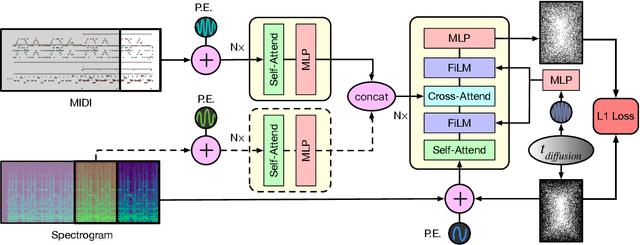


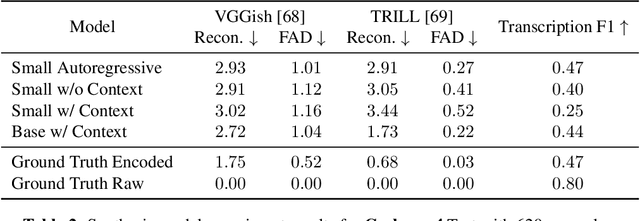
Abstract:An ideal music synthesizer should be both interactive and expressive, generating high-fidelity audio in realtime for arbitrary combinations of instruments and notes. Recent neural synthesizers have exhibited a tradeoff between domain-specific models that offer detailed control of only specific instruments, or raw waveform models that can train on all of music but with minimal control and slow generation. In this work, we focus on a middle ground of neural synthesizers that can generate audio from MIDI sequences with arbitrary combinations of instruments in realtime. This enables training on a wide range of transcription datasets with a single model, which in turn offers note-level control of composition and instrumentation across a wide range of instruments. We use a simple two-stage process: MIDI to spectrograms with an encoder-decoder Transformer, then spectrograms to audio with a generative adversarial network (GAN) spectrogram inverter. We compare training the decoder as an autoregressive model and as a Denoising Diffusion Probabilistic Model (DDPM) and find that the DDPM approach is superior both qualitatively and as measured by audio reconstruction and Fr\'echet distance metrics. Given the interactivity and generality of this approach, we find this to be a promising first step towards interactive and expressive neural synthesis for arbitrary combinations of instruments and notes.
General-purpose, long-context autoregressive modeling with Perceiver AR
Feb 15, 2022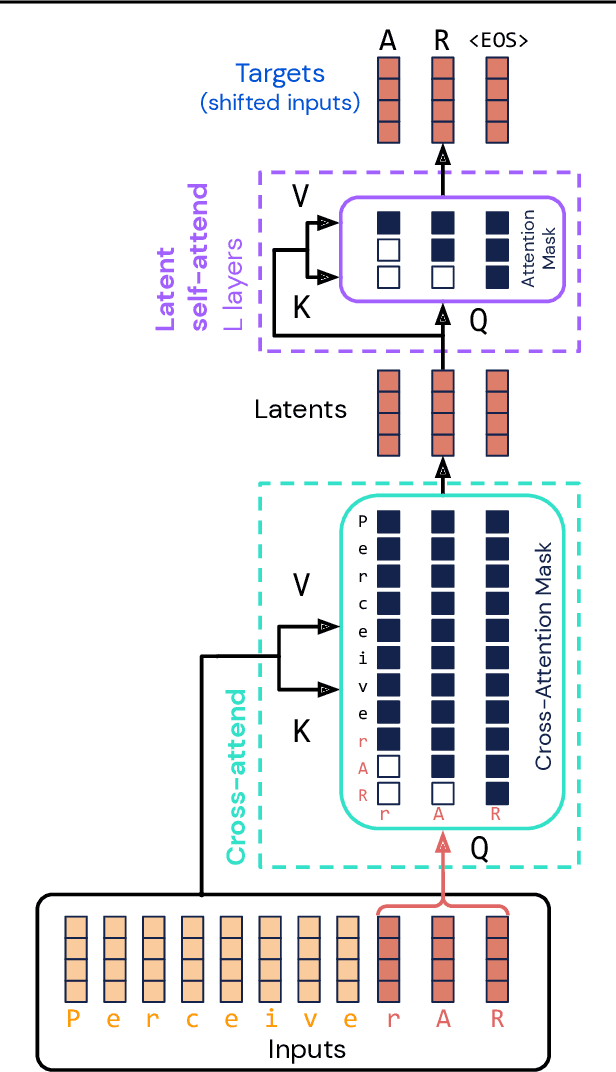
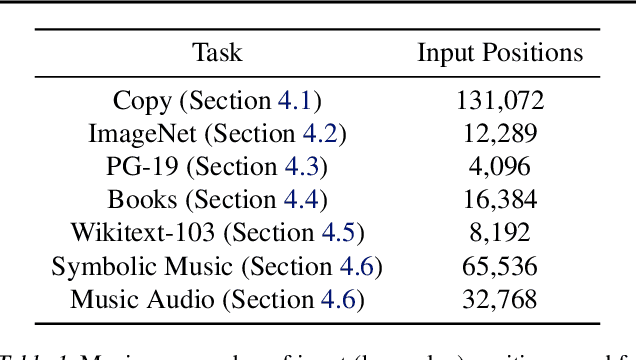
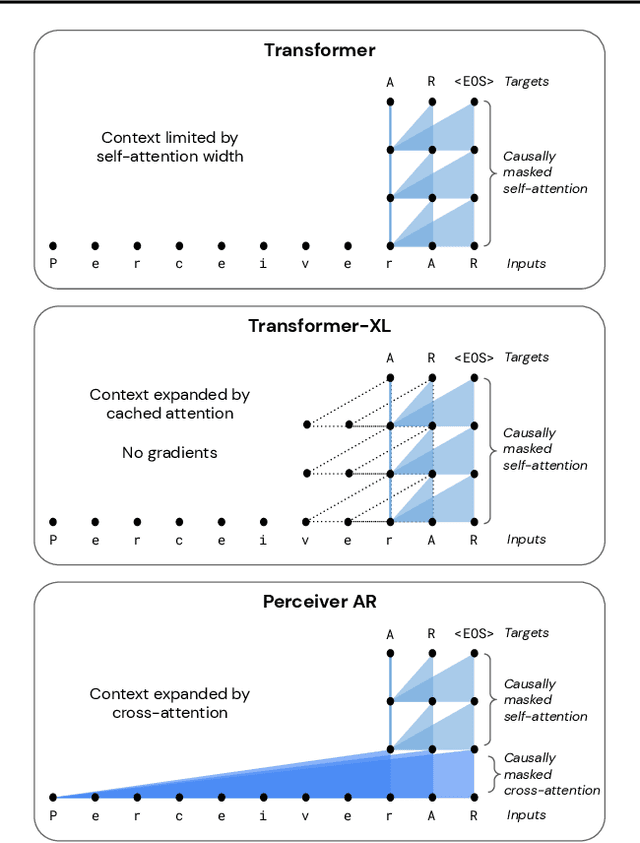

Abstract:Real-world data is high-dimensional: a book, image, or musical performance can easily contain hundreds of thousands of elements even after compression. However, the most commonly used autoregressive models, Transformers, are prohibitively expensive to scale to the number of inputs and layers needed to capture this long-range structure. We develop Perceiver AR, an autoregressive, modality-agnostic architecture which uses cross-attention to map long-range inputs to a small number of latents while also maintaining end-to-end causal masking. Perceiver AR can directly attend to over a hundred thousand tokens, enabling practical long-context density estimation without the need for hand-crafted sparsity patterns or memory mechanisms. When trained on images or music, Perceiver AR generates outputs with clear long-term coherence and structure. Our architecture also obtains state-of-the-art likelihood on long-sequence benchmarks, including 64 x 64 ImageNet images and PG-19 books.
MT3: Multi-Task Multitrack Music Transcription
Nov 10, 2021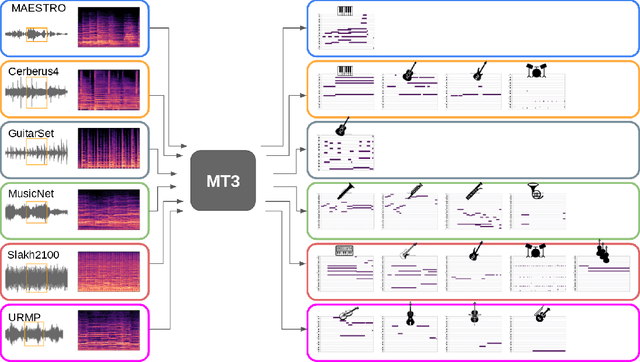


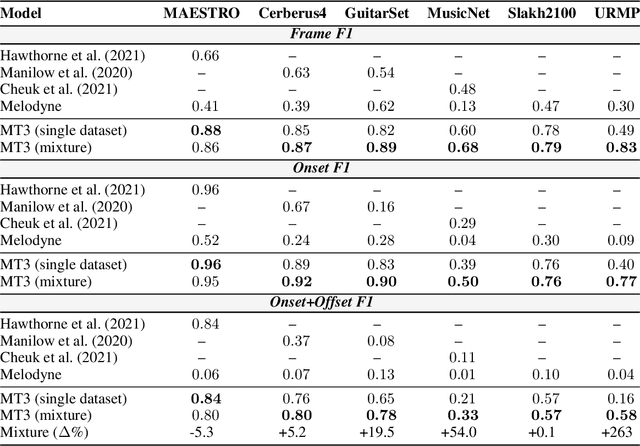
Abstract:Automatic Music Transcription (AMT), inferring musical notes from raw audio, is a challenging task at the core of music understanding. Unlike Automatic Speech Recognition (ASR), which typically focuses on the words of a single speaker, AMT often requires transcribing multiple instruments simultaneously, all while preserving fine-scale pitch and timing information. Further, many AMT datasets are "low-resource", as even expert musicians find music transcription difficult and time-consuming. Thus, prior work has focused on task-specific architectures, tailored to the individual instruments of each task. In this work, motivated by the promising results of sequence-to-sequence transfer learning for low-resource Natural Language Processing (NLP), we demonstrate that a general-purpose Transformer model can perform multi-task AMT, jointly transcribing arbitrary combinations of musical instruments across several transcription datasets. We show this unified training framework achieves high-quality transcription results across a range of datasets, dramatically improving performance for low-resource instruments (such as guitar), while preserving strong performance for abundant instruments (such as piano). Finally, by expanding the scope of AMT, we expose the need for more consistent evaluation metrics and better dataset alignment, and provide a strong baseline for this new direction of multi-task AMT.
Sequence-to-Sequence Piano Transcription with Transformers
Jul 19, 2021



Abstract:Automatic Music Transcription has seen significant progress in recent years by training custom deep neural networks on large datasets. However, these models have required extensive domain-specific design of network architectures, input/output representations, and complex decoding schemes. In this work, we show that equivalent performance can be achieved using a generic encoder-decoder Transformer with standard decoding methods. We demonstrate that the model can learn to translate spectrogram inputs directly to MIDI-like output events for several transcription tasks. This sequence-to-sequence approach simplifies transcription by jointly modeling audio features and language-like output dependencies, thus removing the need for task-specific architectures. These results point toward possibilities for creating new Music Information Retrieval models by focusing on dataset creation and labeling rather than custom model design.
Symbolic Music Generation with Diffusion Models
Mar 30, 2021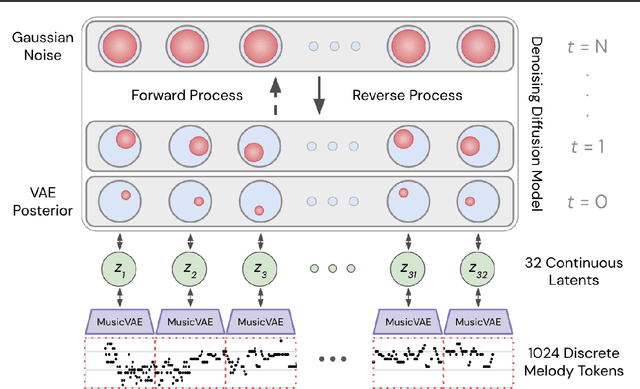

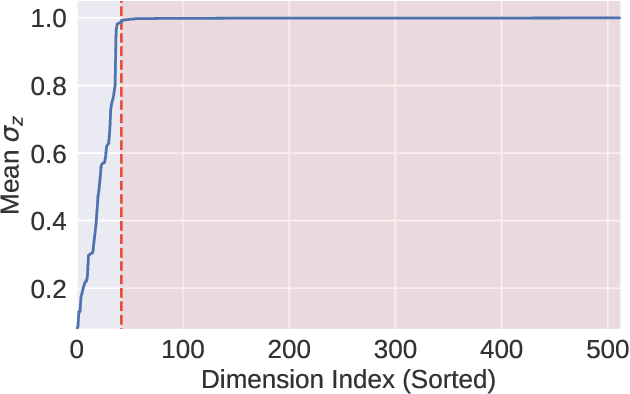

Abstract:Score-based generative models and diffusion probabilistic models have been successful at generating high-quality samples in continuous domains such as images and audio. However, due to their Langevin-inspired sampling mechanisms, their application to discrete and sequential data has been limited. In this work, we present a technique for training diffusion models on sequential data by parameterizing the discrete domain in the continuous latent space of a pre-trained variational autoencoder. Our method is non-autoregressive and learns to generate sequences of latent embeddings through the reverse process and offers parallel generation with a constant number of iterative refinement steps. We apply this technique to modeling symbolic music and show strong unconditional generation and post-hoc conditional infilling results compared to autoregressive language models operating over the same continuous embeddings.
 Add to Chrome
Add to Chrome Add to Firefox
Add to Firefox Add to Edge
Add to Edge